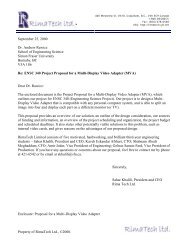Fleksibilni Internet servisi na bazi kontrole kašnjenja i
Fleksibilni Internet servisi na bazi kontrole kašnjenja i
Fleksibilni Internet servisi na bazi kontrole kašnjenja i
You also want an ePaper? Increase the reach of your titles
YUMPU automatically turns print PDFs into web optimized ePapers that Google loves.
5.2. BPR + : an optimized BPR scheduler<br />
Optimized Backlog-Proportio<strong>na</strong>l Rate (BPR + ) is a new scheduler that considers<br />
not only the lengths of throughput-sensitive and delay-sensitive queues, but also the<br />
arrival times of individual packets when it assigns service rates to the queues [38]. We<br />
were motivated by the need to know the form of an optimal scheduler for proportio<strong>na</strong>l<br />
delay differentiation, even if it might be to complex to be practical. In our simulation<br />
study, we use BPR + as a benchmark for evaluating BPR performance.<br />
BPR + is based on a fluid traffic model. We provide here a set of definitions that<br />
are used to characterize the fluid traffic model.<br />
We say that a server is busy if there are packets in queues waiting to be<br />
transmitted. The input curve R in (t) is defined as a cumulative amount of traffic that has<br />
entered a queue since the beginning of the current busy period. The output curve R out (t) is<br />
the cumulative amount of traffic that has been transmitted from the queue since the<br />
beginning of the current busy period [39], [40]. An example of input and output curves is<br />
shown in Fig. 8. At every moment, service rate of a queue is equal to the slope of its<br />
output curve. Vertical and horizontal distance between input and output curve are current<br />
backlog and delay, respectively.<br />
Input and output curves for throughput-sensitive class ( R (t)<br />
in<br />
TS and R (t)<br />
out<br />
TS ) and<br />
delay-sensitive class ( R (t)<br />
in<br />
DS and R (t)<br />
out<br />
DS ) are shown in Fig. 9. If TS queue is served with<br />
out<br />
rate R (τ ) at time τ, the average delay of TS backlog d TS can be calculated as a sum of<br />
TS<br />
experienced delay<br />
E<br />
d TS and expected residual delay<br />
31<br />
R<br />
d TS :<br />
E<br />
R<br />
d ( τ ) = d ( τ ) + d ( τ ) . (12)<br />
TS<br />
TS<br />
TS






